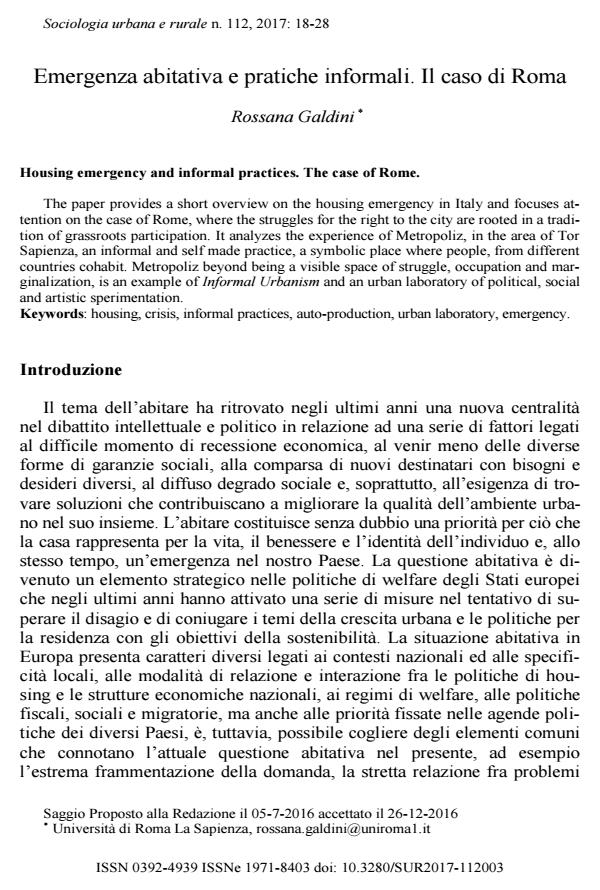Housing emergency and informal practices. The case of Rome.
Journal title SOCIOLOGIA URBANA E RURALE
Author/s Rossana Galdini
Publishing Year 2017 Issue 2017/112
Language Italian Pages 11 P. 18-28 File size 417 KB
DOI 10.3280/SUR2017-112003
DOI is like a bar code for intellectual property: to have more infomation
click here
Below, you can see the article first page
If you want to buy this article in PDF format, you can do it, following the instructions to buy download credits

FrancoAngeli is member of Publishers International Linking Association, Inc (PILA), a not-for-profit association which run the CrossRef service enabling links to and from online scholarly content.
The paper provides a short overview on the housing emergency in Italy and focuses attention on the case of Rome, where the struggles for the right to the city are rooted in a tradition of grassroots participation. It analyzes the experience of Metropoliz, in the area of Tor Sapienza, an informal and self made practice, a symbolic place where people, from different countries cohabit. Metropoliz beyond being a visible space of struggle, occupation and marginalization, is an example of Informal Urbanism and an urban laboratory of political, social and artistic sperimentation.
Keywords: Housing, crisis, informal practices, auto-production, urban laboratory, emergency.
- Becker J. (2014). Nella periferia centrale. In C. Cellamare (a cura di). (2014a). S.M.U.R., Roma città autoprodotta. Roma: Manifestolibri.
- Berdini P. (2014). Le città fallite. Milano: Donzelli.
- Brillembourg A., Feireiss K., Klumpner H. (2005). Informal City: Caracas Case. Munich: Prestel.
- Careri F. (2001). Walkscapes: Walking as an Aesthetic Practice. Barcelona: Gustavo Gili.
- Cellamare C. (2014a). Roma città autoprodotta. Roma: Manifestolibri.
- Cellamare C. (2014b). Autorganizzazione, pratiche di libertà e individuazione. Territorio, 68. DOI: 10.3280/TR2014-068003
- de Certeau M. (1984). The Practice of Everyday Life. Berkeley: University of California Press.
- Ferrarotti F., Macioti M.I. (2009). Periferie. Da problema a risorsa. Bari: Laterza.
- Foucault M. (1977). Microfisica del potere: interventi politici. Torino: Einaudi.
- Galdini R. (2012). L’abitare difficile. Napoli: Liguori.
- Giddens A. (2000). Il mondo che cambia. Bologna: il Mulino.
- Harvey D.H. (2000). Spaces of Hope. Berkeley-Los Angeles: University of California Press.
- Hernandez F., Kellett P., Allen L.K. (Eds.). (2010). Rethinking the informal city: critical perspectives from Latin America. New York-Oxford: Berghahn books.
- Hou J. (Ed.) (2010). Insurgent Public Space. London: Routledge Taylor & Francis Group.
- Koolhaas R. (1994). Small, Medium, Large, Extra-Large. Rotterdam: J.Sigler.
- Lefebvre H. (1976). La produzione dello spazio. Milano: Moizzi Editore.
- Nomisma-Federcasa (2009). Edilizia pubblica insufficiente: ne usufruiscono 700.000 famiglie, 1/3 di chi versa in situazioni di disagio. --Testo disponibile al sito: http://www.nomisma.it/images/COMUNICATISTAMPA/2016-01-9_NOMISMA_FEDERCASA_rev.pdf. Consultato il 30/12/2016.
- Roy A. (2009). Urban Informality: Toward an Epistemology of Planning. Journal of the American Planning Association, 71. DOI: 10.1080/01944360508976689
- Tosi A., Cremaschi M. (2001). Housing policies in Italy. Vienna: Centre for Comparative Research in the social sciences.
- Wirth L. (1938). Urbanism as a Way of Life. The American Journal of Sociology, 44. DOI: 10.1086/21791
- Different Strategies of Housing Design Rossana Galdini, Silvia Lucciarini, (ISBN:978-1-78984-385-9)
Rossana Galdini, Emergenza abitativa e pratiche informali. Il caso di Roma in "SOCIOLOGIA URBANA E RURALE" 112/2017, pp 18-28, DOI: 10.3280/SUR2017-112003